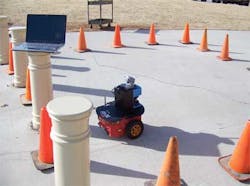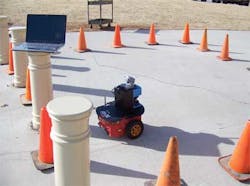VISION-GUIDED ROBOTICS: Intelligent robot performs bridge integrity analysis
After such tragic events as the collapse of the I-35W Mississippi River Bridge in Minneapolis, MN, there has been increased awareness of the need to inspect the structural integrity of bridges throughout the United States. At present, this inspection is a dangerous manual process prone to human error and limited accuracy.
Dr. Zeyong Shan of Safety Vision (Houston, TX, USA) and Prof. Weihua Sheng with his students Ronny Lim and Hung La of Oklahoma State University (Stillwater, OK, USA) have developed a robotic crack inspection and mapping (ROCIM) system that can conduct accurate assessments of cracking on bridge decks (see figure). In the design of the ROCIM system, a Canon VC50i camera from Canon USA (Lake Success, NY, USA) and a LMS-200 laser sensor from Sick (Waldkirch, Germany) were interfaced to a mobile PC and mounted on a Pioneer 3-DX mobile robot from Mobile Robots (Amherst, NH, USA).
cracking on bridge decks.
Crack inspection and mapping require building a 2-D map of the bridge deck using the laser scanner, navigating the robot to collect image data, and then generating a visual map that highlights any cracks in the structure. Before the map can be built, however, the position of the camera relative to the robot must be determined. This calibration process is performed using the MATLAB Camera Calibration Toolbox from The MathWorks (Natick, MA, USA) using a pre-defined grid pattern.
As the robot traverses the bridge, a bridge deck map is created using the simultaneous localization and mapping (SLAM) algorithm that is used in conjunction with a Monte Carlo localization (MCL) algorithm to accurately position the robot at any particular position on the bridge. Simultaneously, captured images from the camera are processed by the on-board computer to detect any cracks that may be present.
To begin image processing, a Laplacian of Gaussian (LoG) algorithm is applied to each image. This algorithm combines Gaussian filtering to remove any noise within the image with the Laplacian operator used for edge detection. This isolates noise and small structures within the image before it is filtered. Multiple images and their locations can then be used to generate a crack map of the structure. Crack locations in the image coordinate system are mapped to the robot coordinate system and transformed into a global coordinate system.
The mobile robot must collect all the images on the bridge deck efficiently, so the camera's field of view needs to capture images across the entire bridge deck, and the inspection time and the distance traveled by the robot must be simultaneously minimized. By analyzing the camera's field of view, a simple motion template for the robot was developed and Boustrophedron motion is used to generate the most efficient path.
To validate the ROCIM system and the image-processing algorithms used, the crack detection algorithm was evaluated using real crack images collected from a bridge deck. After the LoG algorithm was applied, it was established that the algorithm successfully detects cracks as small as 1 mm in the image.

